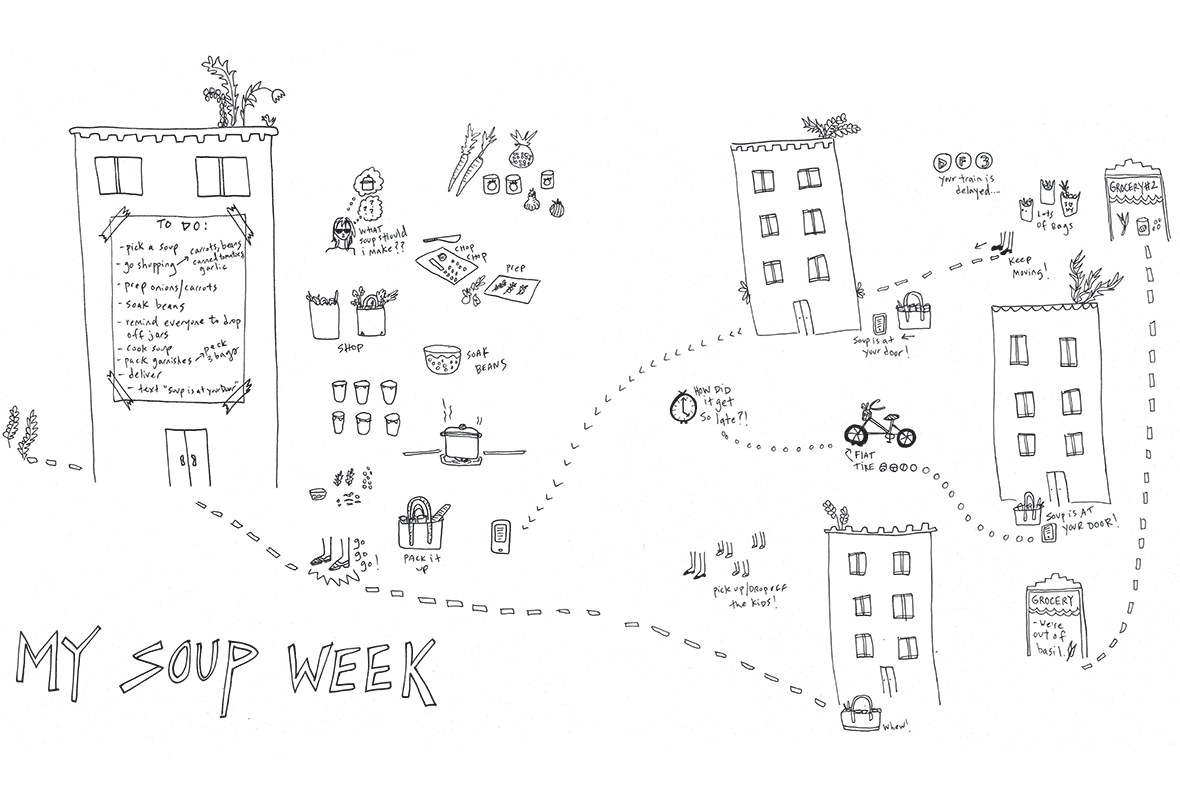
Soup Club Manifesto
We declare that soup shall be shared.
Why soup? Soup scales up and travels well.
Soup is economical, basic, and nondenominational.
Soup club is a state of being, not a monthly meeting.
We are not limited to special occasion soup
For holidays, births, moving, or grief.
The magical delivery of soup to your door
Is elemental to soup club.
Salt your soup. Embrace crushed red pepper.
A black belt is a white belt who never quit. Make your soup.
Never apologize for your soup.
Make soup with abandon.
Remember, it’s just soup.
You will need a bigger pot.
Caroline, Courtney, Julie & Tina
We are four friends who cook. And we are Soup Club.

It began as a conversation. We missed each other but couldn’t always eat together. So we started a club. What we do is simple: We take turns cooking big pots of soup, enough to feed our four families. We drop off the soup, along with sides and garnishes, at the homes of our three other club members. This happens once a week, which means that we each cook our big pot of soup once a month. The other three weeks, we are treated to one another’s home cooking.
If you are already in the habit of cooking in quantity, expressly to share food with your friends and family, then the idea of doing so on a regular schedule will resonate. If you’re used to cooking on a smaller scale, you might enjoy the wider net you can cast with food, when you know it will be enjoyed in other homes. Giving soup is as satisfying as receiving soup. It’s a virtuous cycle. Soup Club makes everyone happy.

This is a guide for starting your own Soup Club—the logistics (there are just a few), the essential tools (ditto), and stories (to caution and inspire).
Who is in soup club?
Anyone who likes soup and wants to play by the rules of Soup Club. We are an educator, an ecologist, a filmmaker, a nutritionist, a yogi, a traveler, a feminist, a mother, a runner, a Dane, a Jew, a Yankee, a Christian, a vegetarian, a gardener, and a coffee drinker. Although there are no hard and fast rules for how many people can be in Soup Club, four members is a good start. Everyone’s turn comes once a month, not too often or too infrequently. The barrier to entry is low.
More important than knife skills is a commitment to cooking at home on schedule and sharing the results. That means that your best friend—a wonderful cook—who has a job that takes her out of town for days at a time without notice might not be a great choice for Soup Club (but you can still share soup with her, because you’re a food-sharing kind of person). On the other hand, do start a Soup Club with that intriguing co-worker whose homemade lunch always looks lovingly prepared, or your neighbor who waters your plants when you’re away…and ask them to invite a couple of people they’d like to share food with, too.

When does soup happen?
Once a week. Establish your Soup Day and a time of day when the soup will be delivered so that you know which meal is covered. Wednesday by dinnertime works for us. You will start to plan around it, whether it’s turning Soup Night into your family dinner or inviting friends over for a homemade meal (even if it wasn’t cooked in your home).
How much soup?
One quart per adult is the basic rule of thumb. Depending on each member’s household, this works out to four to eight quarts of soup each week, which even a small kitchen can handle. Most of these soups stand alone as a meal, and whether you live with other soup-eating mammals or not, you know you’ll have some leftovers.
When cooking in this quantity, everything takes longer: chopping, sautéing, boiling, cooling soup for delivery. Also, you use more salt than you might think, and way more fridge space. Everything ultimately gets divided into four portions, including garnishes and sides. Bulking up a soup is possible, so add that leftover carrot, stray potato, or half onion, and taste as you go. As caretakers of orphaned produce, we are inclusive. Soup is forgiving.

Where does the soup get delivered?
Here’s a key principle: THE COOK DELIVERS THE SOUP. Yes, once a month, the cook is doing ALL the work. Otherwise, everyone will get bogged down in a swamp of coordinating, and no one will be able to pick up soup at the same time. We have always left soup hanging on each other’s doors. If your Soup Club shares a geographic point of convergence—work, house of worship, the gym, school—all the better. Send word to your fellow Soup Club members to let them know what is awaiting them and how to eat it; texting was made for Soup Club notifications. And to keep this well-oiled machine running, Soup Club recipients will drop off their CLEAN soup jars for next week’s cook, usually no later than the day before Soup Day. “Never return an empty jar,” is a long-held principle in food-sharing communities, but in this case returning an empty jar breaks no social codes.
What not to do

Giving up is not an option. Your soup week will sometimes fall at the most inconvenient moment in your busy life. Just know that everyone’s soup week will occur at an equally busy time for them. Get cooking.













I’ve been wanting to do this for a while & I am figuring out logistics. How do you deal w vegetarians in the group?
Terrific to hear, Deborah. I recall the authors discussing this very topic in the book and basically they say it’s up to you and the others in your group. I recall that their approach to the vegetarian in their group was to start the soup vegetarian and then set aside a portion for the vegetarians and then add meat to the rest of the soup. So for example, maybe you make a gazpacho recipe and then for those non-vegetarian families you could include some cooked shrimp on the side for them to add or if you’re making split pea soup after the vegetarian’s portions are packaged you could stir chopped ham into the rest of the soup. Obviously you may be swapping vegetable stock for chicken or beef stock and this won’t work for every recipe, but it gives you some inspiration without having to impose the vegetarian regime on the entire group. I’m certain you have ample soup recipes you love, but just in case you’re always seeking inspiration, here are our Our favorite soup recipes.
I love soup. In fact we started our own organization that feeds the community soup. Check us out.
Best of luck with the endeavor, Anthony.
Oh for Heaven’s Sake! I need another cookbook like I need…… 🙂 But, it’s cold out and soup is calling my name, so. Anxious to look thru it – hmmm, wonder if any quinoa soups in it.
Jean, I hear you. And I wouldn’t be surprised if there were quinoa….!